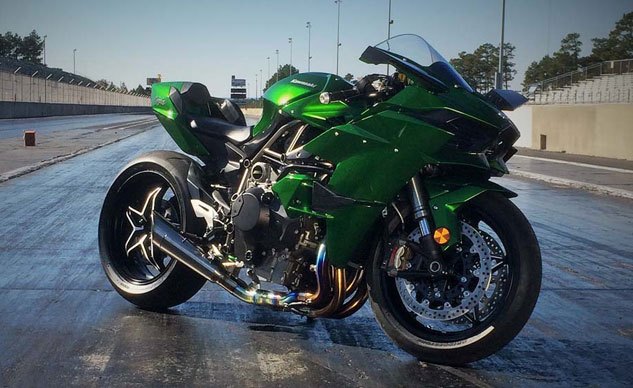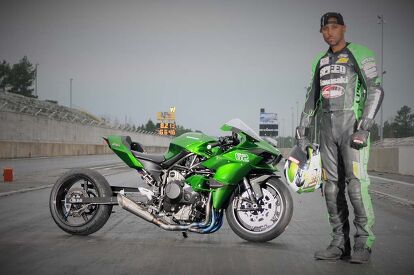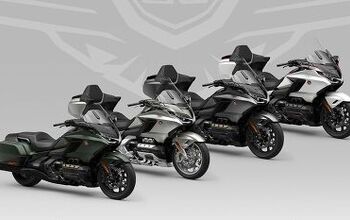Riding Kawasaki's Supercharged Ninja H2/H2R: Rickey Gadson Interview + Video
Legendary dragracer on riding the sportbike sensation of 2015
Kawasaki’s H2 street machine and H2R racebike are likely the most talked about motorcycles of 2015. Engineering a supercharger into a liter-class sportbike is a mighty technological feat, and the H2/H2R shifts the paradigm of what’s possible in a sportbike engine. The EPA-legal H2 is said to produce about 200 crankshaft horsepower, while the closed-course-only H2R claims at least 300 hp.
Rickey Gadson, the 11-time dragracing champion who played a role in developing the H2s, says Kawasaki’s horsepower claims might be underestimated. “I believe that the numbers are politically correct. The one I rode did not feel like 199 horsepower, so you can kiss my butt when it comes to that. My butt knows what 199 feels like, and that wasn’t it.”
2015 Kawasaki Ninja H2 Preview
Gadson’s involvement with the H2s stretches back more than a year and began at Kawasaki’s 2012 dealer meeting when Kawasaki Heavy Industries president Scott Kiyama asked Gadson if he wanted to “be involved with something that I could not know about.”
2012 Kawasaki ZX-14R Review + Video
Although Gadson has been sponsored by Kawasaki since 1996 – Kawi’s longest-contracted athlete – this would be the first time it had enlisted Gadson’s help in developing a new motorcycle. The process began in November 2013 when Gadson received a call from Kiyama-san asking him to travel to Japan to test a prototype of the H2.
“I was floored that the president of KHI asked me to do that,” Gadson explains, “that he valued my opinion enough to ask me to come over and be involved.”
And so Gadson flew to Japan to ride a bike he knew nothing about. His introduction to the H2, code-named “8200,” began on Thanksgiving day during a conference at KHI with the president and the H2’s engineering team. The room was filled with engineers, and two motorcycles sat covered in sheets in the middle of the floor. When they pulled off the sheets, “Wow, I was floored!”
2015 Kawasaki Ninja H2 at EICMA + Video
As Gadson looked over the radical new machines, he was surrounded by engineers who were writing down his observations. “Everybody was writing down everything I was saying, which I thought was amazing that they were that detailed. The guys over there at KHI had a lot of respect for my knowledge of motorcycles and what it took to make this thing what they wanted it to be.”
Gadson recalls asking KHI’s president: “What would make you guys retool and spend this kind of money to make a bike like this when you are already on top of the game? Your flagship motorcycle (the ZX-14R) is already the quickest and fastest and most powerful motorcycle ever made. He gave me the coolest response ever. ‘Because we can.’”
Kawi had one last surprise for Gadson: a computer rendering of an H2 “RG’d out,” with a stretched swingarm, pipe and Gadson’s sponsors and graphics applied to the winged superbike.
Following a day at the Tokyo Motor Show, Gadson and the H2 crew went to one of Kawi’s private test facilities that contained an eighth-mile dragstrip. First up was just some familiarization blasts so Gadson could learn how the H2 responded to his prodding.
“I went through the gearbox, short-shifted every gear, and got to fourth gear and nailed the throttle – I figured in fourth gear I’m safe,” Gadson recalls. “And the gas tank punched me in the chest! That got my attention! It is a handful, to say the least.”
Discuss this at our Kawasaki Ninja H2 Forum.
Then it was time for some acceleration runs, which proved to be quite a challenge even for one of dragracing’s best riders. The H2 has so much brute power that Gadson was initially unable to fully open the throttle during his eighth-mile sprints because its front wheel kept flinging itself skyward.
“Trying to get the throttle opened on that thing was such a challenge,” Gadson recalls about the prototype that hadn’t yet been fitted with its electronic rider aids. “It took a lot of patience!”
In Gadson’s dragracing school, he instructs students to quickly get the throttle open as soon as the clutch is released. “Well, you can’t ride an H2 like that. If you snap the throttle to get the bike to launch forward, you’ll be laying on your back before you’ll be going forward.”
Rickey explains that he struggled to get the throttle fully opened before the eighth-mile finish line. Several passes later, he was able to get it pinned about 600 feet out, slightly before the eighth-mile (660-foot) mark.
Meanwhile, Gadson was also making back-to-back passes with a ZX-14R, the quickest production streetbike on earth. After getting off the 1000cc H2, Gadson says the intensely powerful, 1441cc ZX-14R felt very docile and easy to ride, commenting, “And we all know the ZX-14R is not docile!”
At the end of the day, Gadson says he went about 1.5 tenths quicker on the H2. While that might not sound like much of a difference, it’s important to remember that the H2’s throttle was fully opened for less than a second during the eighth-mile runs. Also noteworthy is the H2’s tidier wheelbase, 1.0 inch shorter than the 14R’s 58.3 inches, which increases its tendency to wheelie and, hence, inhibit maximum acceleration.
Gadson says he was thrilled to ride the H2, but the excitement grew brighter the next day when he got his first crack at the H2R. “I just couldn’t believe what I was looking at – the exhaust, the wings … the H2 didn’t have all that stuff.”
Before hitting the strip, Gadson made some familiarization runs around the facility with his wife and KHI engineers watching. Gadson says his wife, Kiana, never gets excited watching him ride, but this time was different.
“She was so excited to hear the echo of that thing!” Gadson relates. “Just the echo of it coming toward them, how it sounded and the swirl of dust that was behind me like an F-18 fighter plane. When I stopped, I whispered to my wife, ‘I’ve never been so scared in my life.’ I was only scared because the front end never wanted to be on the ground!
“I want to be honest with you, Kevin,” Rickey continues. “I’ve been on every configuration motorcycle known to man, and nothing ever excited me and scared me at the same time like the H2R did. And when I say scared me, it took me so long to get the throttle open, and the whole time I was rolling the throttle on, it was trying to pick the wheel up.”
A late start to the day resulted in an abbreviated test session. Nevertheless, and despite the short track, Gadson was able to bag times that were 2.5 tenths quicker than the 14R. Most impressive was his 15-mph faster trap speed, a massive difference over just one-eighth mile, especially when taking into account that he only got to full throttle for a brief moment before the finish line. “I knew I was on something special by that point, for sure.”
The Philadelphia native has had years of riding motorcycles with boosted engines, but almost all of them have been turbocharged. He says the biggest difference between a supercharger and a turbocharger is there is absolutely no lag. “When you twist the throttle, you have instantaneous response. With a turbo, when you twist the throttle, it’s going to be a pig until it gets to, like, 6000 (rpm), and then it’s going to go crazy on you.”
Gadson was back at KHI the next day for a debriefing. He sat in the center of the room surrounded by “at least 45 to 50 Japanese engineers,” according to Gadson. ”They had a Powerpoint presentation on everything that I had said the last three days. Every opinion I had, my reaction after I got off the motorcycle, the things I told my wife, like everything was up on this Powerpoint presentation. It was amazing how they were so detailed and held on to every word. I left there with the most amazing feeling of accomplishment ever that anyone could have.”
In the first half of 2014, Gadson’s involvement with the H2 consisted mainly of emails between himself and the 8200’s lead designers and Kiyama. He had to wait until October for his next ride, when an H2 was shipped to him via a Kawasaki warehouse in Atlanta. Rickey’s H2 is unlike any other, as it is equipped with an H2R state of tune.
The H2/H2R hybrid continued its impressive ways once strapped to the dyno. It spat out about 275 hp to its rear wheel despite a very rich fuel mixture, a state of tune that preserves engine life at the expense of ultimate power. Leaning it out and adding a Power Commander V picked up a corral of extra ponies, peaking at a stout 296 hp on pump gas.
Dyno testing is fun with a motorcycle as powerful as the H2, but dragstrip testing is, literally, where the rubber meets the road. To limit weight transfer, Gadson’s H2 was lowered via Wonderlinks adjustable shock linkage and the fork strapped down.
“I had the same feeling that I had in Japan, learning how to ride again,” Gadson explains about riding his H2 on home soil, a hint of frustration in his voice. “I couldn’t go faster than the 14 at first because I couldn’t get the throttle open. It took me so long to get the throttle open!”
The champion dragracer could’ve taken advantage of the H2’s electronic traction, wheelie and launch controls, but he rode with them all switched off. “You know me, I’m old school,” Gadson laughs. “I feel like I can go faster than any machine can help me go, so my ego did not let me.”
Back to back, on the same day, the lowered 14R and slightly less-lowered H2 ran identical ETs: 9.16 seconds. The big difference came at the top end, with the 14R hitting a relatively paltry 148 mph (!) compared to the H2’s blazing 160-mph trap speed.
The 14R’s longer wheelbase and “docile” power gave it an advantage off the line, getting to the 330-foot mark two-tenths of a second ahead of its supercharged sister because full throttle couldn’t be exploited due to wheelie concerns. And, at the eighth-mile mark, the ZX remained ahead by 0.17 second.
However, the H2’s massive power was able to be employed in the back half of the track, rapidly gaining on the normally aspirated 14R. “On the second half of the racetrack, the bike did a 3-flat back-half versus a 3.19 on the ZX-14,” Gadson explains. “So it made up almost two-tenths from the eighth-mile to the quarter-mile alone. What you have to take in consideration is that’s at partial throttle until halfway down the racetrack, whereas you’d be at full throttle (on the 14R).”
The next step in transforming the H2/H2R to a serious dragstripper was fitting it with a longer swingarm that extended its wheelbase to 68 inches. In addition, Gould Motorsports made tweaks to the ECU.
With less of a propensity to wheelie during his next dragstrip session, Gadson says he was finally able to use full throttle in second gear. As a result, a full second was trimmed off his ET on the stock-wheelbase H2, dipping to a phenomenal 8.21-second blast.
“That’s how much of a beast that thing is to ride,” Gadson relates, “but it’s so much fun!”
Today at the IMS show in New York, Gadson was able to give his H2/H2R its first public unveiling, another proud moment for the racer with a family history of association with Kawasaki. Gadson’s father, Richard Sr., was a stunt rider in his youth who became affiliated with Kawasaki in the 1970s. Sadly, Gadson’s dad perished after colliding with a car in 1979 while riding his six-cylinder KZ1300 when Rickey was a young teen.
Upon reflection, Gadson looks back at his involvement in the H2’s development as a highlight of his career. “For me to end up riding for the company of the motorcycle that (his dad) loved so much and died on, it’s just such an overwhelming feeling that I would be in Japan with that much weight on my shoulders, you know?
“That was absolutely, by far, the biggest thing that has ever happened to me,” Gadson continues, “to be in Japan at that table with the people that design motorcycles. To have this much value placed on, not just my riding ability, but just my knowledge of motorcycles and what I know that the public wants to see. How can it get any bigger than that?
More by Kevin Duke
























































Comments
Join the conversation
200hp for the h2? Isnt that the same as the new bmw s1000rr? Dont get me wrong, 200 horses is way more bike than I can handle. I just thought it had more.
Kawasaki H2 MOTO-D Swingarm Stands in stock, if you have an H2 and need stands check out http://www.motodracing.com/...